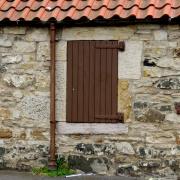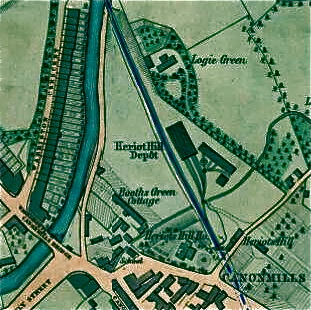
Gurneth Ghatoray – managing director of Rayprographics Ltd – has applied for planning permission to demolish the existing buildings at 5 Warriston Road and build a 3-storey block of flats in their place (Ref. 14/02315/FUL).
The plans for 10 dwellings include subterranean parking for 10 cars, 10 cycles, and 10 bins. (Bit of a theme here.)
Vehicular access would be from Warriston Road, and pedestrian access from Boat Green.
The two penthouse flats would have 3 rather than 2 bedrooms each, and enjoy paved terraces overlooking the Water of Leith and Warriston Crescent beyond.
Spurtle finds the designs inoffensive, although we would miss the down-to-earth stone-built property which stands on the street front at present. Before its current use as part of a larger printshop complex, it served as a photographer's and, we think we remember, an animation studio. Can readers recall or research uses further back than that?
Interestingly, the name Boat Green probably derives from Booth’s Green, originally a bleaching ground set up in the mid-18th century. The seemingly water-related spelling only appeared in a map of 1817, and was adopted by the Council for a new street here in 1982. The detail below is from W. & A.K. Johnston’s 1851 Plan of Edinburgh and Leith.

----------------
 Janice Johnson another nice old building swept away-really awful, what`s wrong with Edinburgh, we don't value these.
Janice Johnson another nice old building swept away-really awful, what`s wrong with Edinburgh, we don't value these.
 Andy Leggatt Not profitable for the council. They think more of raking in taxes than they do of the city's heritage. O and don't forget their constant pandering to the tourists and the great influx of Festival goers. I ran a business in The Old Town for years and not once did I benefit from The Festival. The drum bangers on The High Street regularly made more than I did without any crippling overheads. This city is run by idiots.
Andy Leggatt Not profitable for the council. They think more of raking in taxes than they do of the city's heritage. O and don't forget their constant pandering to the tourists and the great influx of Festival goers. I ran a business in The Old Town for years and not once did I benefit from The Festival. The drum bangers on The High Street regularly made more than I did without any crippling overheads. This city is run by idiots.
 Since posting the article above, with its plea for more information on the building's history, Spurtle has rediscovered its copy of the often useful Joyce M. Wallace (1994) Canonmills and Inverleith (Edinburgh: John Donald Publishing Ltd). Wallace says the building dates from the late 18th Century, and began as a farmyard cottage. By the mid-19th Century it was serving as a gatehouse for Heriothill Station, then housed a 'mussel boiler'. In the last century, Janet Adam rescued it from dereliction to operate as the Canonmills Pottery until 1983. Wallace credits Adam with having pieced together much of the building's past.
Since posting the article above, with its plea for more information on the building's history, Spurtle has rediscovered its copy of the often useful Joyce M. Wallace (1994) Canonmills and Inverleith (Edinburgh: John Donald Publishing Ltd). Wallace says the building dates from the late 18th Century, and began as a farmyard cottage. By the mid-19th Century it was serving as a gatehouse for Heriothill Station, then housed a 'mussel boiler'. In the last century, Janet Adam rescued it from dereliction to operate as the Canonmills Pottery until 1983. Wallace credits Adam with having pieced together much of the building's past.